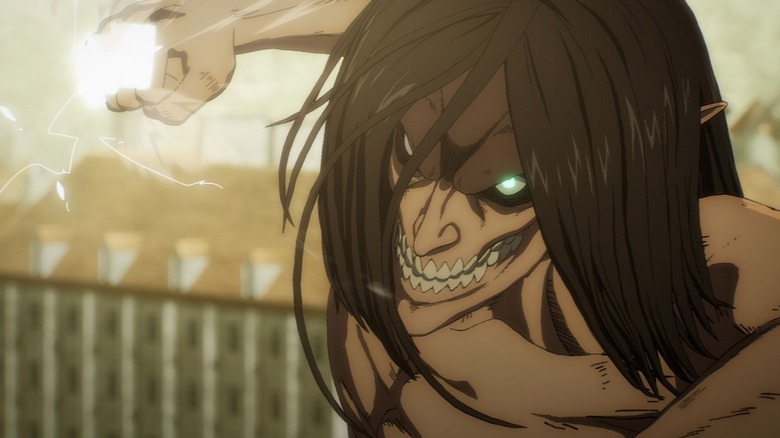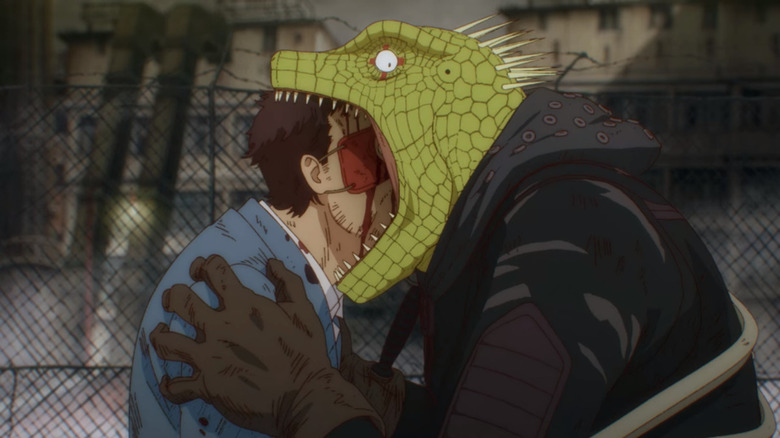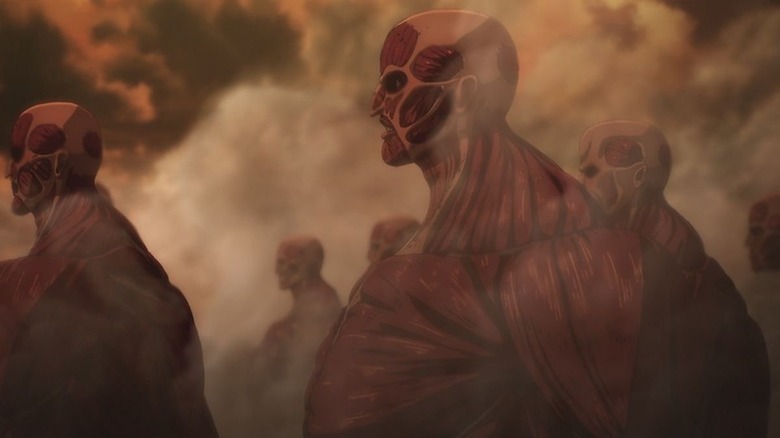The Anime That Inspired Attack On Titan's Shift To CGI
CGI, the three letters that shall not be named. A term that gets the same reactions as the name Voldemort, the cause of all the problems in the anime industry, according to anime fans. It's the plague that has even ruined all major animation studios in the U.S., according to animation fans.
The debate has been plaguing "Attack on Titan" from even before they turned the words "Final Season" into a farce. From the very beginning, the show has used CGI to aid the animation, from camera movement, to small weapons and details. However, when Studio WIT started using CG animation to depict the Colossal Titan starting in season 2, the difference was noticeable. Then, after season 3, the anime changed studios and MAPPA came on board. They expanded the use of CG from just the one Titan to all nine, and at times, the human characters too.
"Today, it's becoming more and more common to use CGI for anime," said Yuichiro Hayashi, director of "Attack on Titan: The Final Season" (Part One) in an interview with Japan Forward. And it all began thanks to one anime about a man with the head of a lizard.
A lizardman influenced a titan
In the interview, Hayashi says that the anime that inspired the use of CGI in "Attack on Titan" was another anime he was working on right before joining "Titan," "Dorohedoro."
"Because I used a lot of CGI for 'Dorohedoro,' I wanted to have continuous management control over MAPPA's CGI team. I didn't think turning every character into CGI would work. However, we thought it would be good if we depict the 9 Titans with CGI. Given the timeline from 'Dorohedoro,' I think it's quite natural."
The "Dorohedoro" anime is one of the most bizarre shows to come out the past few years. Released on Netflix outside of Japan, the show is also visually striking, with CGI being used to provide more expressive character movements and dynamic action, while the 3D visuals helped create a feeling of watching a world that is not quite right. The show follows a man with amnesia trying to kill whoever is responsible for giving him a reptile head.
Now, for "Attack on Titan," making every Titan a CG-animated character was a brilliant choice. Where in past seasons, seeing just the Colossal Titan done with CGI was distracting — with the two mediums never really blending in that well — seeing CG-Warhammer Titan fight CG-Attack Titan is a lot more seamless. Did it all work? Absolutely not, but part two of the final season showed vast improvements in portraying the scale of the story, and given where the story is going, having to move to CGI was a necessity.
Hayashi does have a good point about what may be a big problem with CG animation. As a hand-drawing animator, Hayashi was not trained to work with CG, and he says neither are most people involved with CGI in anime. "Recently, anime that uses partial or full CGI have been on the increase, but I don't think CGI animators are much involved in them," he said.
'CGI is just another tool like pencils and brush pens'
When asked if he was concerned about negative reactions from viewers due to the shift to CGI in "Attack on Titan," Hayashi had this perfect response.
"To tell you the truth, I am a bit surprised that foreign viewers raised this issue. Compared to Japan, foreign animations use much more CGI. Maybe that's why they want hand drawing in animations from Japan."
After you apply a cold compress to that sick burn injury, consider this: why are we more concerned about Japanese animation staying 2D rather than support Western 2D animation and call out bad CGI here? Plenty of animated shows still do great 2D and even hand-drawn animation, but you don't hear about them that much on social media, and you don't get wave after wave of complaints when a new studio animated movie is released in CGI.
Hayashi continued:
"CGI is just another tool like pencils and brush pens. We don't intend to put an emphasis on CGI, nor are we fixated on one technique or the other. For us, CGI exists as an expansion of animation."
This right here. This is the key to understanding CGI. Like 2D animation, CGI can be used very well or very poorly. "Beastars" is a show that could only exist thanks to CGI, with fluid character movement and action that takes full advantage of the format's three dimensions. Even the early seasons of "Attack on Titan" used CGI in order to give us the fantastic ODM-gear scenes, allowing the camera to move around and swing along with the characters. Of course, there is bad CGI, like the atrocious crime against animation, "Ex-Arm."
In the West, we're starting to see studios experiment with ways to use 3D CG animation for more than just the illusion of realism, with highly stylized movies and TV shows following the success of "Spider-Man: Into the Spider-Verse."
As for Hayashi, he believes in using CGI to enhance the hand-drawn animation, even if it means cutting back.
"I make storyboards from an animator's perspective. I believe the moves of characters won't have the right impact unless they are within the limitations of hand drawing. So, if I find cuts and moves which look like 'CGI', I draw fixed moves by hand and ask the CGI animators to adjust the movement frame by frame. The sum of many small changes makes CGI comparable to hand drawing."
"Attack on Titan: Final Season Part 2" is streaming on Crunchyroll and Funimation.


